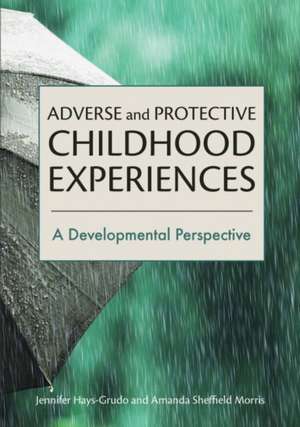Adverse and Protective Childhood Experiences – A Developmental Perspective
Autor Jennifer Hays–grudo, Amanda Sheffiel Morrisen Limba Engleză Paperback – 23 mar 2020
Preț: 430.05 lei
Nou
Puncte Express: 645
Preț estimativ în valută:
82.29€ • 86.15$ • 68.09£
82.29€ • 86.15$ • 68.09£
Carte disponibilă
Livrare economică 17-31 martie
Preluare comenzi: 021 569.72.76
Specificații
ISBN-13: 9781433832116
ISBN-10: 1433832119
Pagini: 236
Dimensiuni: 178 x 253 x 16 mm
Greutate: 0.43 kg
Editura: Wiley
ISBN-10: 1433832119
Pagini: 236
Dimensiuni: 178 x 253 x 16 mm
Greutate: 0.43 kg
Editura: Wiley
Cuprins
Preface: The Hole in the Bridge
Acknowledgements
I. The Effects of Adverse and Protective Childhood Experiences
1. Adverse Childhood Experiences
The Adverse Childhood Experiences Study
ACEs Studies in Other Populations
ACEs in Children and Adolescents
Defining ACEs
Knowing One’s ACE Score
2: Protective and Compensatory Experiences: The Antidote to ACEs
PACEs: Relationships and Resources
PACEs Foundational Theories and Research
Our Research on PACEs
Knowing One’s PACE Score
Part II. How Early Experience Influences the Body, Brain, and Behavior
3. Effects of Early Life Adversity on Neurobiological Development
Models of Biobehavioral Responses to Childhood Adversity
Epigenetics and Childhood Adversity
Effects of Childhood Adversity on Brain Structure and Function
Putting It All Together: The ICARE Model
4. The Intergenerational Transmission of ACEs and PACEs
Psychosocial Transmission of Adversity and Resilience
Neurobiological Transmission of Parenting
Neurobiological Transmission of Adversity and Resilience
Conclusions and Activity: ACEs and PACEs Genograms
III. Breaking the Cycle of ACEs and Increasing PACEs
5. Repairing the Effects of ACEs in Adulthood
ACE-Based Science as a Foundation for Interventions
PACEs for Adults
Conclusions and Activity: Creating an Adult PACEs Plan
6. Promoting Positive Development in Children with ACEs
PACEs for Children
PACEs for Adolescents
Enhancing Neurobiological Regulation
Fostering Positive Caregiver–Child Relationships
Systems-Level Programs
Conclusions and Activity: Creating a Child PACEs Plan
7. ACEs and PACEs and Communities
The Historical and Social Context of ACEs
Trauma-Informed Practices
Community Coalitions Focused on ACEs and Resilience
Policy Change and Legislation
Adverse Community Environments and Adverse Childhood Experiences: A Pair of ACEs
8: Putting It All Together: Summary and Solutions
What We Have Learned
Solutions—What to Do Next
Finding A Life Raft
Appendix: Questions for Reflection
Resources
References
Index
About the Authors
Acknowledgements
I. The Effects of Adverse and Protective Childhood Experiences
1. Adverse Childhood Experiences
The Adverse Childhood Experiences Study
ACEs Studies in Other Populations
ACEs in Children and Adolescents
Defining ACEs
Knowing One’s ACE Score
2: Protective and Compensatory Experiences: The Antidote to ACEs
PACEs: Relationships and Resources
PACEs Foundational Theories and Research
Our Research on PACEs
Knowing One’s PACE Score
Part II. How Early Experience Influences the Body, Brain, and Behavior
3. Effects of Early Life Adversity on Neurobiological Development
Models of Biobehavioral Responses to Childhood Adversity
Epigenetics and Childhood Adversity
Effects of Childhood Adversity on Brain Structure and Function
Putting It All Together: The ICARE Model
4. The Intergenerational Transmission of ACEs and PACEs
Psychosocial Transmission of Adversity and Resilience
Neurobiological Transmission of Parenting
Neurobiological Transmission of Adversity and Resilience
Conclusions and Activity: ACEs and PACEs Genograms
III. Breaking the Cycle of ACEs and Increasing PACEs
5. Repairing the Effects of ACEs in Adulthood
ACE-Based Science as a Foundation for Interventions
PACEs for Adults
Conclusions and Activity: Creating an Adult PACEs Plan
6. Promoting Positive Development in Children with ACEs
PACEs for Children
PACEs for Adolescents
Enhancing Neurobiological Regulation
Fostering Positive Caregiver–Child Relationships
Systems-Level Programs
Conclusions and Activity: Creating a Child PACEs Plan
7. ACEs and PACEs and Communities
The Historical and Social Context of ACEs
Trauma-Informed Practices
Community Coalitions Focused on ACEs and Resilience
Policy Change and Legislation
Adverse Community Environments and Adverse Childhood Experiences: A Pair of ACEs
8: Putting It All Together: Summary and Solutions
What We Have Learned
Solutions—What to Do Next
Finding A Life Raft
Appendix: Questions for Reflection
Resources
References
Index
About the Authors
Notă biografică
Descriere
By integrating existing knowledge about dverse childhood experiences with developmental research on preventing, buffering, and treating the effects of adversity, stress, and trauma on child development and subsequent health and functioning, this book identifies the most important positive childhood experiences.
